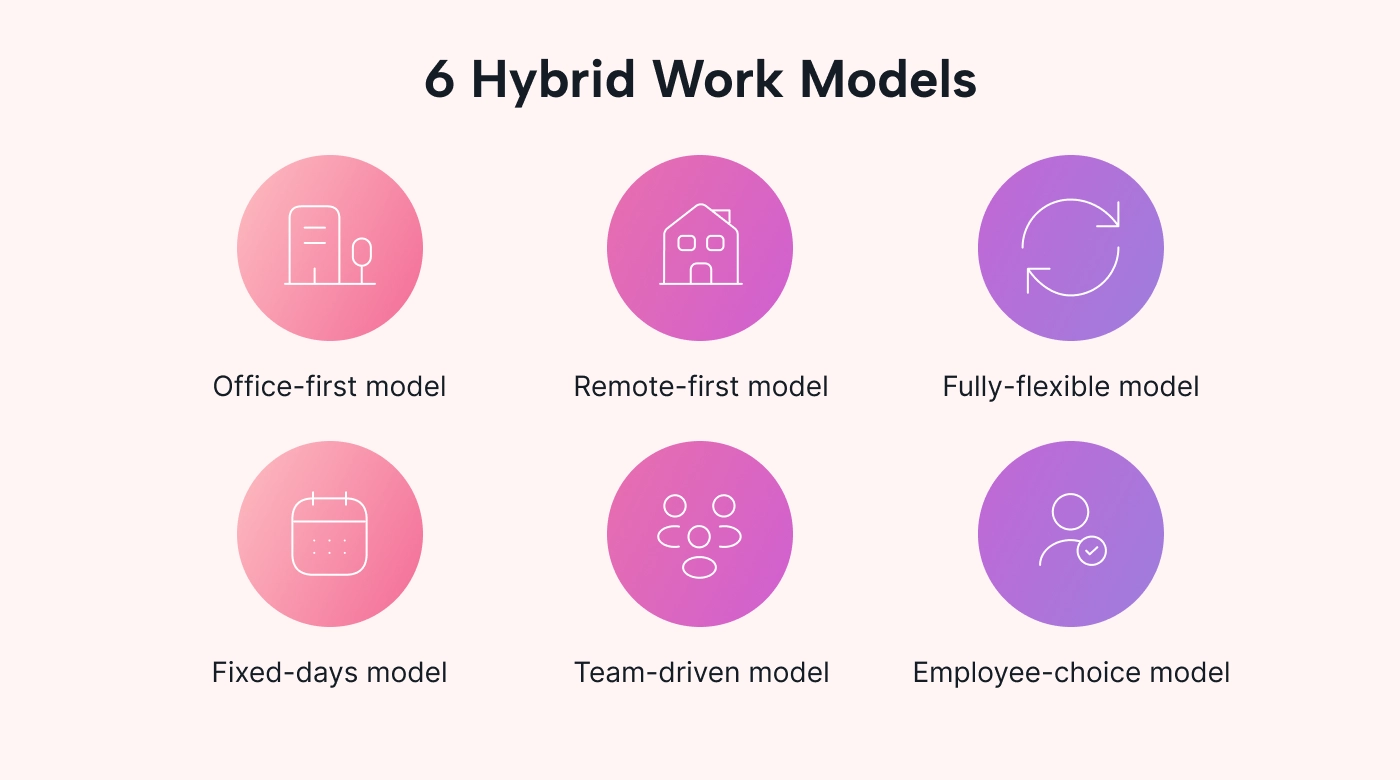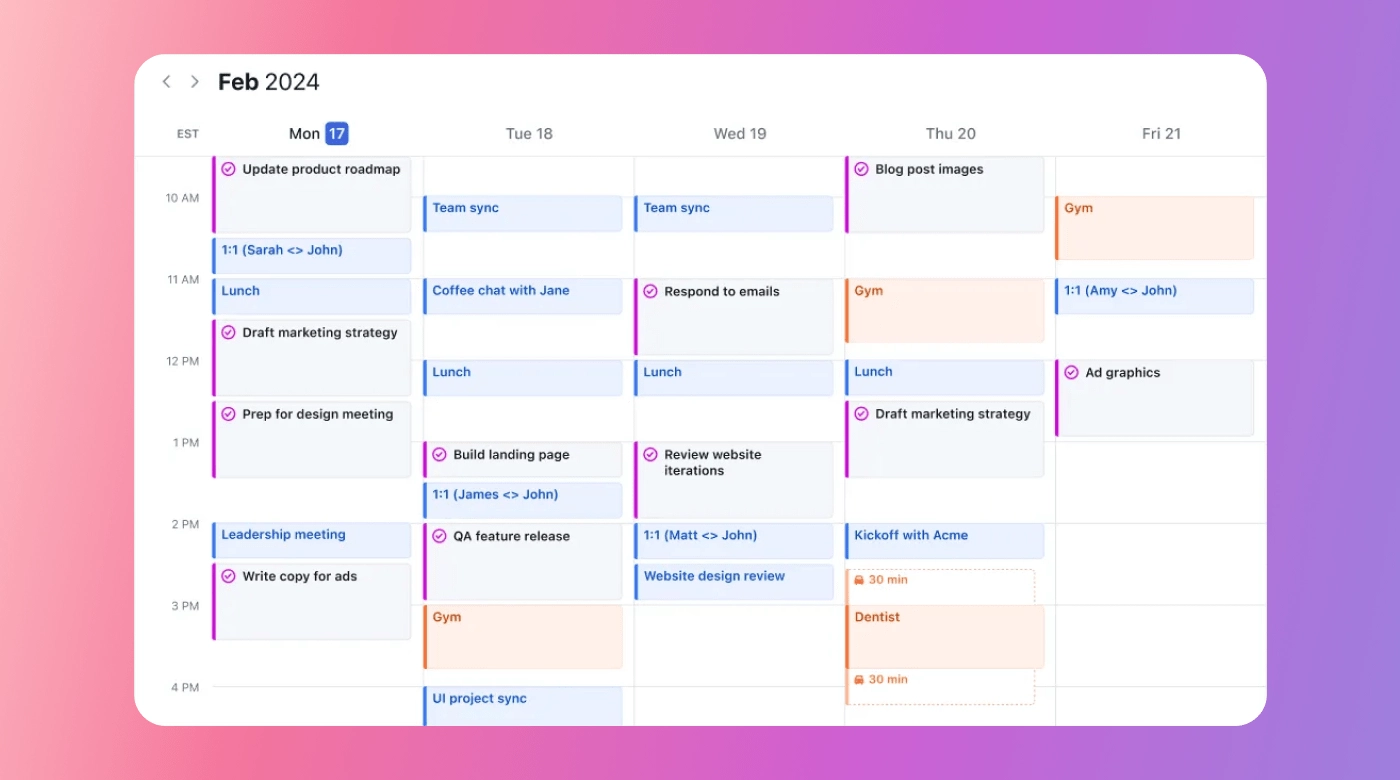You’ve experienced the good and bad of both office-based working and working from home. But what if you could have the best of both worlds?
Going hybrid could be the answer.
Many people enjoy the flexibility that hybrid work offers. In fact, 70% of managers and 87% of employees feel more productive when they have a flexible schedule.
However, building a successful hybrid culture comes with challenges. For example, how can hybrid companies maximize productivity while still fostering connection and inclusivity?
This article delves into the essence of hybrid culture in the workplace, exploring its benefits, challenges, and strategies for implementation. Read on to learn all you need to know to make the transition.
What is a hybrid culture?
A hybrid culture refers to a working environment where employees perform a mix of in-office and remote work. Eighty-three percent of global workers prefer a hybrid model, so many employers are considering offering more flexible work options to keep their employees happy.
There are multiple options when it comes to organizing a hybrid workplace. Here are six of the most common hybrid work models, each of which offers a different combination of office-based and remote work:

- Office-first model: This model offers primarily in-office work, with an option to work from home for perhaps one to two days a week.
- Remote-first model: Employees carry out most of their work remotely, although they may work from the office on occasion.
- Fully-flexible model: Flexible working gives employees the right to choose if and when they work from the office.
- Fixed-days model: This is a prearranged agreement where a worker works from home on set days each week.
- Team-driven model: Here, a team’s individual roles, responsibilities, and need for in-office resources determine whether its members can work remotely.
- Employee-choice model: Here some in-office work is expected, but employees can decide for themselves how their remote vs in-office schedules will look.
Real examples of hybrid work models in action
While it can be challenging to envisage options for hybrid working if you’re used to a more traditional in-office workplace, there are plenty of real-life examples to copy. Here are two of our favorite case studies if you need a little inspiration.
Microsoft built a whole new hybrid workplace culture post-pandemic, including new collaboration methods, security procedures, and adapted office spaces.
Salesforce allows leaders to make decisions on in-office attendance based on specific job roles and employee preferences.
Hybrid work can offer improved performance, connection, and flexibility for employees compared to fully remote or fully in-office workers. However, a company’s goals and the nature of the work it performs will impact whether or not a hybrid model makes sense for it.
Let’s look a little deeper at the benefits and challenges of a hybrid culture.
The benefits of a hybrid culture
Many modern employers are attracted by the many benefits of a hybrid workplace culture. Here are a few of them:
Attract top talent
With growing numbers of workplaces now offering flexible working, employers must consider going hybrid to stay competitive. In addition to being a significant draw to the modern employee, hybrid models allow businesses to access a wider range of talent that extends beyond the organization’s immediate area.
Better work-life balance
A hybrid model can improve employees’ work-life balance. This, in turn, can help reduce stress levels, boost employee satisfaction, and increase retention.
Cost savings
Employers who implement a hybrid work model can reduce spending on office space and resources, giving them significant financial savings. Workers benefit as well by saving on commuting, childcare, and other expenses. This makes hybrid work a cost-effective solution for all.
Improved productivity
Fifty-nine percent of managers believe that remote working boosts productivity, translating to better business performance. By offering flexibility, hybrid work environments can enhance employee focus and efficiency, ultimately driving better revenue and growth.
The challenges of a hybrid culture
While there are many pros to a hybrid culture in the workplace, there are also some challenges.
Employees list a lack of access to resources as their top challenge. In a hybrid setup, for example, workers may not have access to tools like phone systems or security-protected programs. Support may also not be as readily available, potentially causing operational delays.

Communication in a hybrid workplace also becomes more complex, with fewer face-to-face interactions. Without effective communication, vital information can get lost, leading to misunderstandings and a lack of team cohesion. Fortunately, technologies like Slack, Zoom, or Microsoft Teams can help bridge this gap.
Another significant challenge is the potential for hybrid workers to feel isolated, which can impact team dynamics and overall morale. In fact, a notable 28% of hybrid employees report feeling less connected to their colleagues.
Employers can proactively foster a sense of community through the following:
- Virtual meetings
- Team-building activities
- Transparent feedback systems
Finally, security concerns can arise as remote work opens up new points of entry for cyberattacks on workplace software. Organizations should invest in cybersecurity measures and provide ongoing training to employees to mitigate these risks and protect sensitive company information.
Steps to build a successful hybrid culture
So, is the hybrid work model worth it?
Although it may take an initial time and financial investment, transitioning to a hybrid model can pay off in the long run in terms of business output, evolving employee preferences, and cost savings.
As the shift toward hybrid and remote work continues to grow, it’s wise to stay ahead of the curve and make the move sooner rather than later. But, a smooth transition to a hybrid work culture requires meticulous planning, transparency, and plenty of support for employees.
Here are the steps to doing it properly:
1. Decide on your preferred hybrid model
The first step in building a successful hybrid culture is selecting the right hybrid model for your organization.
This decision should be based on:
- The type of work performed
- Company goals and culture values
- Employees’ ability to utilize remote systems
- Employee preferences
Consider whether an office-first, remote-first, fully-flexible, fixed-days, team-driven, or employee-choice model aligns best with your organization’s needs. By carefully evaluating the factors above, you can choose a model that maximizes productivity and employee satisfaction.
2. Plan properly and document new systems and policies
Proper planning and thorough documentation are crucial for a smooth transition to hybrid work and help ensure that all employees have a clear understanding of their tasks and responsibilities.
Establish clear policies and systems to:
- Manage work schedules
- Set performance expectations
- Determine communication protocols
- Implement cybersecurity measures
Preparation helps prevent unexpected issues from popping up and provides a structured approach to managing the hybrid work environment. It also helps ensure that everyone company-wide is on the same page.
3. Communicate changes to employees
Transparency is key when transitioning to a hybrid work culture, as it helps alleviate concerns and build trust. Communicate every step of the transition process to your employees to make sure they understand the changes that are happening and how they will impact their work routines.
Clear and consistent communication ensures that employees feel informed and engaged throughout the transition, making the shift to the new hybrid model that much smoother.
4. Adapt the office space or help with home office setups
Adapting workspaces to accommodate hybrid work is essential. By enhancing both employees’ in-office and remote work environments, you can create a seamless and efficient hybrid work experience.
Office adaptations could include the following:
- Installing video conferencing tools in meeting rooms
- Setting up in-office phone booths
- Ensuring that office layouts support both in-person and virtual collaboration

Additionally, consider offering support to employees as they set up their home offices. This might include providing ergonomic furniture, technology stipends, or guidelines on creating a home workspace that fosters productivity.
5. Offer training and support
Training and ongoing support are vital components of a successful hybrid work culture. Provide comprehensive training on new work, collaboration, security, and communication protocols to ensure everyone on your team understands how to operate effectively in the hybrid environment.
Continuous support through workshops, help desks, and feedback systems also helps employees adapt to new systems and practices. Investing in training not only equips them with the necessary skills but also demonstrates your organization's commitment to their success in the hybrid model.
Tips to maintain a healthy hybrid work culture
Creating a healthy hybrid culture is key to ensuring employee satisfaction and retention and maintaining effective operations. Once you’ve made the shift to a hybrid workplace, it’s important to focus on driving a healthy hybrid culture.
Here’s what you can do to make this happen:
Utilize organization tools
Automate business processes using project management and productivity tools to keep everyone organized and connected.
Tools like Slack and Microsoft Teams facilitate seamless communication through instant messaging, video calling, and file sharing — all of which are invaluable for day-to-day communication and collaboration anywhere in the world.
Project management tools such as Trello can help you organize and track tasks.
And apps like Motion are perfect for ensuring your entire team stays productive and organized. Motion has AI capabilities to help you manage your tasks, combat decision fatigue, build out to-do lists to make the perfect schedule, and schedule meetings at times that work for you.

Check-in with employees regularly
Regular check-ins are vital to determining employee needs and addressing any concerns that may arise in a hybrid work environment. Schedule frequent one-on-one meetings and team huddles to provide support, gather feedback, and ensure that employees feel valued and connected.
For instance, a weekly team meeting can be used to discuss ongoing projects, share updates, and address any challenges team members might be facing.
One-on-one meetings offer a more personalized approach, allowing managers to check-in with individual employees to discuss their overall well-being and career development and provide them with tailored support.
By maintaining open lines of communication, employers can build trust and promptly address minor issues before they turn into bigger problems.
Consider security risks
Cybersecurity is a critical concern in a hybrid work setting. You’ll need to take comprehensive measures to protect company data and systems from potential threats.
Effective security might include the following:
- Using secure networks
- Implementing strong password policies
- Regularly updating security protocols
It’s also important to provide employees with training on best practices for remote work security. For example, you might organize workshops or create training videos on recognizing phishing attempts, using virtual private networks (VPNs), and securing home Wi-Fi networks to reduce security risks.
Additionally, ensure that all devices used for work are equipped with updated antivirus software and encryption.
By proactively addressing security concerns, you can protect sensitive information and maintain the integrity of your operations.
Encourage team building
Fostering a sense of community through team-building activities and social events is important when employees often work from home.
Virtual coffee breaks, team lunches, and online games can help employees bond and build relationships despite the physical distances between them.
Consider organizing a monthly town hall meeting or virtual trivia night to provide a fun and interactive way for team members to connect. Encouraging collaboration on projects and creating opportunities for informal interactions can also strengthen a sense of camaraderie.
Regularly scheduled virtual team-building exercises, such as problem-solving activities or creative workshops, can enhance teamwork and improve communication skills. These efforts not only boost morale but can also help employees feel more connected to and engaged with their colleagues.

Provide opportunities for professional development
Offering employees opportunities to enhance their skills and advance in their careers shows that the organization values their growth and long-term success. This can be achieved through online training programs, virtual workshops, and e-learning platforms.
Providing access to courses or certifications in relevant industry skills or even hosting regularly scheduled webinars will not only help employees feel fulfilled but also improve their competencies and, in turn, enhance their workplace performance.
Set yourself up for hybrid success with the right tools
By understanding hybrid work — including its benefits and potential pitfalls — you can create a fruitful and inclusive work environment for your employees. This will allow you to attract top talent, improve your employees’ work-life balance and boost productivity.
However, remember that this change requires meticulous planning, clear communication, and ongoing support. And setting up effective tools like Motion can be key to its success.
Motion is a cloud-based organizational tool that helps you see whether your employees are on track with their tasks. Not only that, but it also reduces the need for manual planning. It can integrate with your workplace tech stack and calendar to help your organization stay productive, no matter where your workers are located.

Ragnar is a Pomodoro enthusiast and a SaaS writer with over 10 years of experience. When he's not focused on getting a sentence just right, he loves cooking and training Muay Thai.




